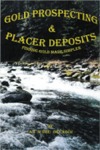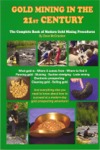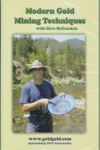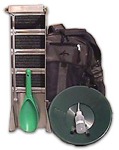|
The
Rocker Box Blog Archive
Playing Hide & Seek with Gold
- Part 1
My 2-cents
Gold is fascinating. Not just to me, but to
people across the world and across time. Why? In its native form,
it’s just shiny metal. Why would people put such value on something
that you cannot eat or drink? In and of itself it’s not going to
keep you alive. Still…for millenniums gold has been valued to the
point that “man” will do just about anything to acquire it…ANYTHING!
Lucky for us, gold can come right out of the ground in a valuable
form without any special processing. In fact, you can sell raw gold
for about twice the “spot” value to collectors, jewelers, and even
tourists. All it takes is to hunt some of that elusive commodity,
and you’re rich…right?
Well…maybe. Just like there’s a difference between fishing and
catching, there’s a difference between prospecting and finding. It’s
a game of Hide & Seek…with the Gold.
Like I said, gold is fascinating. Gold is malleable, which means it
can be pounded into a sheet so thin that you can literally see
through it. Gold is “noble,” meaning it won’t rust, corrode, or
oxidize, making it easy to spot (if the piece is big enough). Gold
is heavy. VERY heavy. Gold is 19.32 times heavier than water, or
almost twice as heavy as lead. This fact gives us a huge advantage
for finding gold in the game of Hide & Seek.

When it breaks out of its “lode” (where it’s located in solid rock),
gold will ALWAYS move downhill. Gravity makes sure of this. So, as
it tumbles down a hill, gold will ALWAYS take the path of least
resistance down. As whatever the gold is sitting on at the time
destabilizes, the gold will continue to move down until it hits
something it cannot penetrate…like bedrock. There are factors that
will assist gold in moving ever father down, including erosion,
water, ground movements…anything that destabilizes what the gold is
sitting on at this moment. What I will mainly concentrate on right
now is water.
Water can move mountains…literally. Water is powerful. If you’ve
ever seen videos (or even see with your own eyes) a flood of water
hitting boulders, you know that when enough water flows, it will
move those huge boulders that can weigh tons. Water can move gold
also. But, it takes A LOT of water pressure to move gold, especially
sideways. But that’s the direction it goes (generally) when water
pushes it in a river…until something happens that lessens that water
pressure. And, that’s the key to our winning the game.

As stated above, it takes A LOT of water pressure to move gold. It
takes a river flowing very fast, like at flood stage, to generate
the pressure necessary to move gold. The biggest boulders in the
river will also be moving during this time. Both the boulders
(rolling down the river) and the gold (crawling across the bedrock)
will keep moving until something happens to lessen the pressure,
leading us to our first clue:
Gold will “Drop” when the water pressure drops.
When the water flows around a curve in the river, the outside of the
curve has the fastest water, therefore the highest water pressure.
The inside of the curve has the slowest water, therefore the least
water pressure.
Therefore…gold can be found at the beginning
and the end of the
INSIDE CURVE AT FLOOD STAGE IN THE RIVER.

In fact, if you stand at the beginning of the inside curve
and look upstream, you’ll probably see a line of big boulders that
seems to go straight for the end of the previous (upstream) curve.
Do you think that just might be a possible paystreak?
If you go down to a river and look at water flowing around any good
size boulder, you’ll notice that there is a slow spot at the top
(upstream) and bottom (downstream) points of the boulder, and fast
water on both sides. Guess what? The slow water at those two points
mean low water pressure. Low water pressure means a location that
gold can “drop” and accumulate.
There are many other clues we can discuss, and we will in future
posts. For now, absorb the above and go down to a local river and
look at how the water flows (at whatever level it is now). Then,
look around at the river bank and imagine how the water would flow
at flood stage. Look for the inside curves. Look for the lines of
boulders. This is the first part of “reading a river” for gold.

There is a lot moree on this subject, and there are many good books
and DVDs on reading a river and prospecting for gold. I recommend
several (above) to increase your knowledge, and as field guides to
take with you in your game of Hide & Seek with Gold!
Regardless if your local river is known for
gold or not, go down there and start practicing "reading" the river
as I have described above. Practice makes perfect, and come treasure
hunting time, you'll be better prepared to Get that Gold!

Full Disclosure: The supplies, equipment, tips,
techniques, and procedures I recommend are based on my evaluation
and experience. I link items I recommend to companies I have an
affiliate agreement with (or to The Rocker Box Catalog) from which I
receive a small percentage of sales if sales are made during your
visit to their website. The recommendations are mine, and mine
alone. I use any proceeds to pay for The Rocker Box website, and to
generate future articles and activities. I thank you in advance for
your patronage and support to further the great recreations,
hobbies, and vocations of treasure hunting, gold prospecting, metal
detecting, ghost town hunting, and rock hounding.
30-Second Bio: I am a retired soldier of the US
Army Special Forces (aka Green Berets), serving for over 25 years. My specialties were communications,
medicine, operations and intelligence, with extensive cross training
in weapons and demolitions. I was a paratrooper, jumpmaster, combat
diver, combat dive supervisor, combat dive medic, sniper, and
pathfinder. I’ve been deployed countless times to locations on four
continents, and have participated in operations in open water,
riverine, jungle, mountain, desert, arctic, and urban
environments…but I’ve been a “treasure Hunter” since I was eight.
The End.
serving for over 25 years. My specialties were communications,
medicine, operations and intelligence, with extensive cross training
in weapons and demolitions. I was a paratrooper, jumpmaster, combat
diver, combat dive supervisor, combat dive medic, sniper, and
pathfinder. I’ve been deployed countless times to locations on four
continents, and have participated in operations in open water,
riverine, jungle, mountain, desert, arctic, and urban
environments…but I’ve been a “treasure Hunter” since I was eight.
The End.
|
